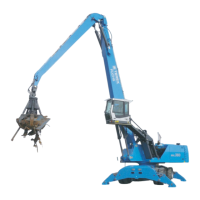SAFETY AND ACCIDENT PREVENTION 2
MHL380 D 2.15
2.3.4 Crack test on the machine
Whatever the reason, location, duration and
conditions of their use, all machines are
subject to a variety of loads. These various
loads result in service lives of differing
lengths for different components of the
machine. This can result in cracks and loose
connections, especially on load-bearing
parts. To maintain operating safety, the
machine must therefore be checked weekly
for cracks, loose connections and other
visible damage.
To check for cracks, it is always necessary
for the machine to be kept clean and be
cleaned regularly.
To carry out these tests, they should be
performed on a solid, level surface, with a
changing load and using equipment in
longitudinal and transverse direction.
Relevant accident prevention requirements
must be observed.
Particular care is required when testing
bearing parts, specifically:
- steel construction undercarriage with axle
and gear bearings, outrigger, lower
slewing ring support and slewing ring
- steel construction uppercarriage with
bearing block for boom and boom
cylinder, upper slewing ring support, cab
bearing, fastening of swing gear and
counterweight
- steel parts of the loading equipment, e.g.
boom, dipperstick and grab
- hydraulic cylinders, axles, steering, bolts
and bolt connection, steps, ladders, and
fastening elements
- The crack test must be performed visually.
To increase test reliability, the color
penetration procedure should be used if a
crack is suspected or in places that are
difficult to see, for example the slewing
ring support.
- Any damage that is discovered must be
repaired immediately. Welding work on
load-bearing parts of loading machines
must only be performed by specialist
personnel, and only in accordance with
accepted welding engineering practice. If
you are in any doubt, consult your dealer
or a TEREX | Fuchs service engineer for
advice on how to proceed.

